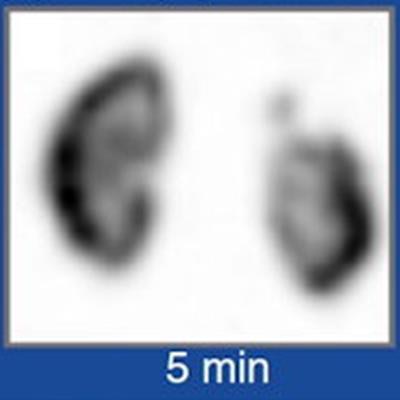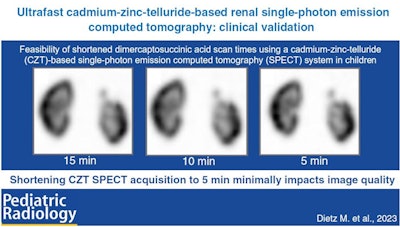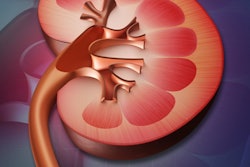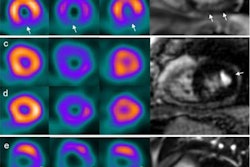
Shorter scan times of five minutes during kidney imaging in children are feasible using newer SPECT cameras with cadmium-zinc-telluride (CZT) detectors, according to a study published May 15 in Pediatric Radiology.
A group led by Dr. Matthieu Dietz of the University of Lyon in France simulated shortened technetium-99m (Tc-99m) dimercaptosuccinic acid (DMSA) SPECT acquisition times in children using a camera with cadmium-zinc-telluride (CZT)-based detectors. Compared to standard planar imaging, the reduced exposure times had minimal impact in terms of quality and reproducibility, they found.
"This significant reduction in scan time could provide greater comfort to children, potentially reducing the likelihood of motion artifacts," the group wrote.
Tc-99m DMSA scintigraphy is a standard approach for imaging the kidneys to assess renal function. In children, common indications for these exams may include detection of scarring or inflammation due to infections, the authors explained. One of the main limitations of these scans is their long acquisition times -- between 15 and 30 minutes -- which is significant, as children are more prone to move during the exams, and this movement limits image quality, they noted.
Newer SPECT cameras equipped with cadmium-zinc-telluride (CZT) semiconductor detectors rather than scintillation crystals may overcome this issue due to improved contrast and energy resolution, but few studies have yet validated the approach, they added.
To that end, the researchers retrospectively analyzed imaging from 27 children (median age, 4 years old) who underwent both planar and SPECT imaging. The reduction in SPECT acquisition time was simulated during software image reconstruction to provide a series of images taken after 15 minutes, 10 minutes, five minutes, and 2.5 minutes. Radiology experts then compared the planar and SPECT imaging series based primarily on quality on a scale of zero to 2.
 A graphical abstract. Image courtesy of Pediatric Radiology through CC BY 4.0.
A graphical abstract. Image courtesy of Pediatric Radiology through CC BY 4.0.The overall image quality score was 1.3 for the planar dataset, 1.6 for the SPECT-15 minute dataset, 1.4 for the SPECT-10 minute dataset, 1.0 for the SPECT-5 minute dataset, and 0.6 for the SPECT-2.5 minute dataset. The radiologists agreed in their rankings in more than 83% of cases.
In addition, this reduction in scan time could equate to a corresponding reduction of Tc-99m radiotracer by 83%, the researchers added.
"Shortening SPECT acquisitions to [five] minutes is feasible with minimal impact on images in terms of quality and reproducibility," the group wrote.
Ultimately, this was a feasibility study based on a retrospective simulation of reduced-count acquisitions with a small sample size and thus, the approach will require additional prospective validation, the researchers concluded.





















